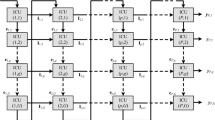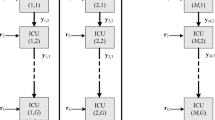Abstract
In this paper, a new linear group-wise parallel interference cancellation (LGPIC) detector is proposed. Four different group-detection schemes are derived, namely, the linear group matched filter PIC (LGMF-PIC) detector, the linear group decorrelator PIC (LGDEC-PIC) detector, the linear group minimum mean square error PIC (LGMMSE-PIC) detector and the linear group parallel interference cancellation weighted PIC (LGPIC-PIC) detector. The convergence behavior of the proposed detector is analyzed and conditions of convergence are derived. Finally, extensive simulations regarding the convergence behavior and the effect of the grouping on the convergence behavior of the proposed LGPIC detector are conducted.
Similar content being viewed by others
References
Kourtis, S., McAndrew, P., & Tottle, P. (1998). W-CDMA: Aspects of implementation.IEE Colloquium on UMTS – The R&D Challenges 23 Nov 1998 (pp. 10/1–10/8).
Grant A., Schlegel C. (2001) Convergence of linear interference cancellation multiuser receivers. IEEE Transaction on Communication 49(10): 1824–1834
Rasmussen L.K., Lim T.J., Johansson A. (2000) A matrix-algebraic approach to successive interference cancellation in CDMA. IEEE Transaction on Communication 48(1): 145–151
Guo D., Rasmussen L.K., Sun S., Lim T.J. (2000) A matrix-algebraic approach to linear parallel interference cancellation in CDMA. IEEE Transaction on Communication 48(1): 152–161
Johansson A.L., Rasmussen L.K. (1998) Linear group-wise successive interference cancellation in CDMA. IEEE 5th Proceedings of the International Symposium on Spread Spectrum Techniques and Applications, 1(2–4): 121–126
Verdu, S. (1998). Multi-user Detection. Cambridge University Press.
Saad, Y. (2003). Iterative Methods for Sparse Linear Systems, (2nd ed.). publisher: SIAM
Rasmussen, L. K., & Oppermann, I. J. (2001). Convergence behaviour of linear parallel cancellation in CDMA. IEEE Global Telecommunication Conference, San Antonio, TX, December 2001. (pp. 3148–3152).
Rasmussen L.K., Oppermann I.J. (2003) Ping-pong effects in linear parallel interference cancellation for CDMA. IEEE Transactions on Wireless Communication 2: 357–363
ETSI TR 101 112, UMTS 30.03, V3.2.0, Annex B, Sections 1.2.3, 1.3, 1.4. 1998.
Author information
Authors and Affiliations
Corresponding author
Rights and permissions
About this article
Cite this article
Bentrcia, A., Zerguine, A. A New Linear Group-Wise Parallel Interference Cancellation Detector. Wireless Pers Commun 49, 23–34 (2009). https://doi.org/10.1007/s11277-008-9553-7
Received:
Accepted:
Published:
Issue Date:
DOI: https://doi.org/10.1007/s11277-008-9553-7




